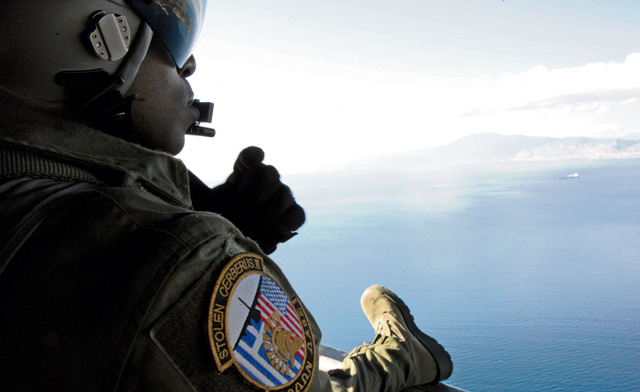
Senior Airman Ralph Colas, 37th Airlift Squadron loadmaster, looks out the back of a C-130J Super Hercules Feb. 3 as it flies over the Greek landscape during Stolen Cerberus II, a flying training deployment in Elefsis, Greece. The FTD is designed to gauge both aircraft and personnel capabilities as well as improve the interoperability of the Airmen and their Greek counterparts.
Elefsis, Greece — U.S. Air Forces in Europe Airmen traveled to Elefsis, Greece, Feb. 1 to participate in Stolen Cerberus II, a two-week flying training deployment designed to gauge both aircraft and personnel capabilities as well as improve the interoperability of the Airmen and their Greek counterparts.
Airmen from the 86th Airlift Wing and the 435th Air Ground Operations Wing, along with Airmen from the 317th Airlift Group from Dyess Air Force Base, Texas, and Soldiers from the 5th Quartermaster Detachment, 21st Theater Sustainment Command, are working alongside the Hellenic air force to complete training not as easily available to each respective unit during the winter months.
“We’re here to strengthen our ties with the Greeks, one of our NATO allies, but we are also here to do training we can’t always do in Germany,” said Capt. Kirk Habrun, Stolen Cerberus II deputy mission commander. “We have a lot of mountainous terrain here we can use in our low-level (flight training) routes we don’t get in a lot of other places in Europe.”
In addition to the landscape provided, Habrun said Greece has weather better suited for flying than Germany in the winter months, which allows pilots to do more training, such as night vision goggle training.
“That’s really hard to come by in Germany, especially in the summer time,” he said. “NVG training is pretty much non-existent. We can come here in the winter when it gets dark quicker and we have good weather.”
The U.S. pilots aren’t the only ones to benefit from the FTD.
“We have gotten to work with the Greeks every single day,” said Staff Sgt. Daniela Cristain, 37th Airlift Squadron aviation research management. “They have been very supportive of
us.”
Cristain said the FTD has been important in building relationships with both the Greeks and the aircrews she directly supports as they work with their counterparts.
The Hellenic air force also benefits from the joint training.
“They get experience re-rigging their loads, because they don’t get to air drop that often,” Habrun said. “The Greeks don’t have as many available C-130 tails as we do since they are committed to other missions, so us coming down here allows them to jump more than they would out of the Greek C-130s.”
Habrun said the Greeks also get good training flying with multiple aircraft in formations.
“For the first time, we flew a formation flight with Greek and American C-130s,” he said. “It allowed us to compare techniques and how we fly in general.
USAFE Airmen get the added bonus of completing upgrade requirements because of the training they are able to complete in Greece.
“We have low-cost, low-altitude qualifications,” Habrun said. “It’s a CDS pallet that’s lighter weight. It’s supposed to be really precise. It’s a cheap way of resupplying troops that may be at a little (forward operating base) or in contact (with an enemy), but since you are flying so low to the ground it can be dangerous as you can get shot at. It’s a special qualification for us.”
The training helps guarantee that both the U.S. and Greek air forces are able to provide airlift support to their own and their NATO allies’ troops anytime, anywhere should the need arise.







